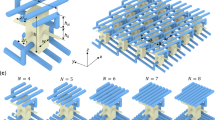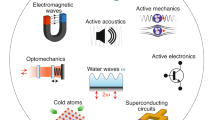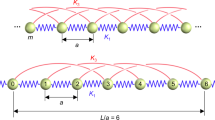Abstract
Identifying material geometries that lead to metamaterials with desired functionalities presents a challenge for the field. Discrete, or reduced-order, models provide a concise description of complex phenomena, such as negative refraction, or topological surface states; therefore, the combination of geometric building blocks to replicate discrete models presenting the desired features represents a promising approach. However, there is no reliable way to solve such an inverse problem. Here, we introduce ‘perturbative metamaterials’, a class of metamaterials consisting of weakly interacting unit cells. The weak interaction allows us to associate each element of the discrete model with individual geometric features of the metamaterial, thereby enabling a systematic design process. We demonstrate our approach by designing two-dimensional elastic metamaterials that realize Veselago lenses, zero-dispersion bands and topological surface phonons. While our selected examples are within the mechanical domain, the same design principle can be applied to acoustic, thermal and photonic metamaterials composed of weakly interacting unit cells.
This is a preview of subscription content, access via your institution
Access options
Access Nature and 54 other Nature Portfolio journals
Get Nature+, our best-value online-access subscription
$29.99 / 30 days
cancel any time
Subscribe to this journal
Receive 12 print issues and online access
$259.00 per year
only $21.58 per issue
Buy this article
- Purchase on SpringerLink
- Instant access to full article PDF
Prices may be subject to local taxes which are calculated during checkout




Similar content being viewed by others
References
Pendry, J. B. Negative refraction makes a perfect lens. Phys. Rev. Lett. 85, 3966–3969 (2000).
Grbic, A. & Eleftheriades, G. V. Overcoming the diffraction limit with a planar left-handed transmission-line lens. Phys. Rev. Lett. 92, 117403 (2004).
Liu, Z., Lee, H., Xiong, Y., Sun, C. & Zhang, X. Far-field optical hyperlens magnifying sub-diffraction-limited objects. Science 315, 1686 (2007).
Li, J., Fok, L., Yin, X., Bartal, G. & Zhang, X. Experimental demonstration of an acoustic magnifying hyperlens. Nat. Mater. 8, 931–934 (2009).
Kaina, N., Lemoult, F., Fink, M. & Lerosey, G. Negative refractive index and acoustic superlens from multiple scattering in single negative metamaterials. Nature 525, 77–81 (2015).
Silva, A. et al. Performing mathematical operations with metamaterials. Science 343, 160–164 (2014).
Bückmann, T., Thiel, M., Kadic, M., Schittny, R. & Wegener, M. An elasto-mechanical unfeelability cloak made of pentamode metamaterials. Nat. Commun. 5, 4130 (2014).
Schurig, D. et al. Metamaterial electromagnetic cloak at microwave frequencies. Science 314, 977–980 (2006).
Tretyakov, S. Analytical Modeling in Applied Electromagnetics (Artech House, Boston, MA, USA, 2003).
Werner, D. H. & Kwon, D.-H. Transformation Electromagnetics and Metamaterials: Fundamental Principles and Applications (Springer, London, UK, 2014).
Sihvola, A. H. Electromagnetic Mixing Formulas and Applications (The Institution of Engineering and Technology, London, UK, 1999).
Gibson, W. C. The Method of Moments in Electromagnetics (Chapman and Hall/CRC, Boca Raton, FL, USA, 2007).
Hao, Y. & Mittra, R. FDTD Modeling of Metamaterials: Theory and Applications (Artech House, Boston, MA, USA, 2008).
Monk, P. Finite Element Methods for Maxwell’s Equations (Clarendon Press, Oxford, UK, 2003).
Caloz, C. & Itoh, T. Electromagnetic Metamaterials: Transmission Line Theory and Microwave Applications (Wiley, Hoboken, NJ, USA, 2005).
Volakis, J. L., Sertel, K. & Usner, B. C. Frequency Domain Hybrid Finite Element Methods for Electromagnetics (Morgan & Claypool, San Rafael, CA, USA, 2006).
Reis, P. M., Jaeger, H. M. & van Hecke, M. Designer matter: a perspective. Extrem. Mech. Lett. 5, 25–29 (2015).
Coulais, C., Teomy, E., de Reus, K., Shokef, Y. & van Hecke, M. Combinatorial design of textured mechanical metamaterials. Nature 535, 529–532 (2016).
Kalinin, S. V., Sumpter, B. G. & Archibald, R. K. Big–deep–smart data in imaging for guiding materials design. Nat. Mater. 14, 973–980 (2015).
Schumacher, C. et al. Microstructures to control elasticity in 3D printing. ACM Trans. Graph. 34, 136 (2015).
Sun, Y., Edwards, B., Alù, A. & Engheta, N. Experimental realization of optical lumped nanocircuits at infrared wavelengths. Nat. Mater. 11, 208–212 (2012).
Li, Y., Liberal, I., Giovampaola, C. D. & Engheta, N. Waveguide metatronics: lumped circuitry based on structural dispersion. Sci. Adv. 2, e1501790 (2016).
Zhang, S., Xia, C. & Fang, N. Broadband acoustic cloak for ultrasound waves. Phys. Rev. Lett. 106, 24301 (2011).
Schrieffer, J. R. & Wolff, P. A. Relation between the Anderson and Kondo Hamiltonians. Phys. Rev. 149, 491–492 (1966).
Bravyi, S., DiVincenzo, D. P. & Loss, D. Schrieffer–Wolff transformation for quantum many-body systems. Ann. Phys. 326, 2793–2826 (2011).
Winkler, R. Spin–Orbit Coupling Effects in Two-Dimensional Electron and Hole Systems (Appendix B). Springer Tracts in Modern Physics, Vol. 191 (Springer-Verlag, Berlin, Germany, 2003).
Wagner, M. Unitary Transformations in Solid State Physics (North Holland, Amsterdam, 1986).
Nemat-Nasser, S. & Srivastava, A. Negative effective dynamic mass-density and stiffness: Micro-architecture and phononic transport in periodic composites. AIP Adv. 1, 1–10 (2011).
Veselago, V. G. The electrodynamics of substances with simultaneously negative values of ϵ and μ. Sov. Phys. Uspekhi 10, 509–514 (1968).
Chalker, J. T., Pickles, T. S. & Shukla, P. Anderson localization in tight-binding models with flat bands. Phys. Rev. B 82, 1–5 (2010).
Mukherjee, S. et al. Observation of a localized flat-band state in a photonic Lieb lattice. Phys. Rev. Lett. 114, 245504 (2015).
Vicencio, R. A. et al. Observation of localized states in Lieb photonic lattices. Phys. Rev. Lett. 114, 1–5 (2015).
Haldane, F. D. M. Model for a quantum Hall effect without Landau levels: Condensed-matter realization of the ‘parity anomaly’. Phys. Rev. Lett. 61, 2015–2018 (1988).
Hasan, M. Z. & Kane, C. L. Colloquium: Topological insulators. Rev. Mod. Phys. 82, 3045–3067 (2010).
Qi, X.-L. & Zhang, S.-C. Topological insulators and superconductors. Rev. Mod. Phys. 83, 1057–1110 (2011).
Susstrunk, R. & Huber, S. D. Observation of phononic helical edge states in a mechanical topological insulator. Science 349, 47–50 (2015).
Nash, L. M. et al. Topological mechanics of gyroscopic metamaterials. Proc. Natl Acad. Sci. USA 112, 14495–14500 (2015).
Wang, P., Lu, L. & Bertoldi, K. Topological phononic crystals with one-way elastic edge waves. Phys. Rev. Lett. 115, 1–5 (2015).
Fleury, R., Sounas, D. L., Sieck, C. F., Haberman, M. R. & Alu, A. Sound isolation and giant linear nonreciprocity in a compact acoustic circulator. Science 343, 516–519 (2014).
Mousavi, S. H., Khanikaev, A. B. & Wang, Z. Topologically protected elastic waves in phononic metamaterials. Nat. Commun. 6, 19 (2015).
Khanikaev, A. B., Fleury, R., Mousavi, S. H. & Alù, A. Topologically robust sound propagation in an angular-momentum-biased graphene-like resonator lattice. Nat. Commun. 6, 8260 (2015).
McHugh, S. Topological insulator realized with piezoelectric resonators. Phys. Rev. Appl. 6, 14008 (2016).
Pal, R. K., Schaeffer, M. & Ruzzene, M. Helical edge states and topological phase transitions in phononic systems using bi-layered lattices. J. Appl. Phys. 119, 84305 (2016).
Süsstrunk, R. & Huber, S. D. Classification of topological phonons in linear mechanical metamaterials. Proc. Natl Acad. Sci. USA 113, E4767–E4775 (2016).
Serra-Garcia, M. et al. Observation of a phononic quadrupole topological insulator. Nature https://doi.org/10.1038/nature25156 (2018).
Lai, A. & Itoh, T. Composite right/left-handed transmission line metamaterials. IEEE Microw. Mag. 5, 34–50 (2004).
Semouchkina, E. A., Semouchkin, G. B., Lanagan, M. & Randall, C. A. FDTD study of resonance processes in metamaterials. IEEE Trans. Microw. Theory Tech. 53, 1477–1487 (2005).
Sihvola, A. Homogenization principles and effect of mixing on dielectric behavior. Photon. Nanostruct. 11, 364–373 (2013).
La Spada, L. et al. Surface wave cloak from graded refractive index nanocomposites. Sci. Rep. 6, 1–8 (2016).
Lin, Z., Pick, A., Lončar, M. & Rodriguez, A. W. Enhanced spontaneous emission at third-order Dirac exceptional points in inverse-designed photonic crystals. Phys. Rev. Lett. 117, 107402 (2016).
Petyt, M. Introduction to Finite Element Vibration Analysis (Cambridge University Press, New York, NY, USA, 2015).
Acknowledgements
This work was partially supported by the ETH Postdoctoral Fellowship to K.H.M., and by the Swiss National Science Foundation. The authors would like to thank R. Süsstrunk and O. Bilal for discussions.
Author information
Authors and Affiliations
Contributions
K.H.M. and M.S.G. performed the optimization and simulation of the materials. K.H.M. wrote the manuscript. M.S.G. proposed the reduction approach and optimization algorithm. A.P. designed and performed the dynamic condensation. S.H. selected and interpreted the reduced-order models. C.D. provided guidance during all stages of the project. All authors contributed to the discussion and interpretation of the results, and to the editing of the manuscript.
Corresponding author
Ethics declarations
Competing interests
The authors declare no competing financial interests.
Additional information
Publisher’s note: Springer Nature remains neutral with regard to jurisdictional claims in published maps and institutional affiliations.
Supplementary information
Supplementary Information
Supplementary Information.
Rights and permissions
About this article
Cite this article
Matlack, K.H., Serra-Garcia, M., Palermo, A. et al. Designing perturbative metamaterials from discrete models. Nature Mater 17, 323–328 (2018). https://doi.org/10.1038/s41563-017-0003-3
Received:
Accepted:
Published:
Issue Date:
DOI: https://doi.org/10.1038/s41563-017-0003-3



